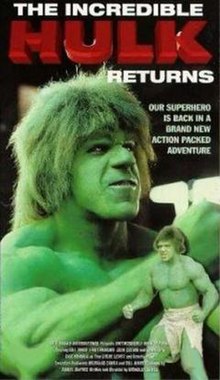
Back Návrat neuvěřitelného Hulka Czech Die Rückkehr des unheimlichen Hulk German Le Retour de l'incroyable Hulk French הענק הירוק חוזר HE Hulk visszatér Hungarian La rivincita dell'incredibile Hulk Italian The Incredible Hulk Returns Dutch The Incredible Hulk Returns Portuguese The Incredible Hulk Returns Serbo-Croatian The Incredible Hulk Returns Turkish
| The Incredible Hulk Returns | |
|---|---|
 | |
| Genre | |
| Created by | Kenneth Johnson |
| Based on | |
| Written by | Nicholas Corea |
| Directed by |
|
| Starring | |
| Theme music composer |
|
| Country of origin | United States |
| Original language | English |
| Production | |
| Executive producers |
|
| Producer | Daniel McPhee |
| Production locations | 30708 Pacific Coast Hwy, Malibu, California Spelling Television Inc. - 5700 Wilshire Boulevard, Los Angeles, California Courtyard Pl, Los Angeles, California Tiffany Court - 616 S Masselin Ave, Los Angeles, California Palomino Nightclub - 6907 Lankershim Boulevard, North Hollywood, Los Angeles, California |
| Cinematography | Chuck Colwell |
| Editors |
|
| Running time | 100 minutes |
| Production companies |
|
| Original release | |
| Network | NBC |
| Release | May 22, 1988 |
| Related | |
| The Incredible Hulk The Trial of the Incredible Hulk | |
| Infobox instructions (only shown in preview) | |
The Incredible Hulk Returns is a 1988 American television superhero film based on the Marvel Comics character the Hulk and serves as a continuation of the 1978–1982 television series The Incredible Hulk.
In The Incredible Hulk Returns, Dr. David Banner, a scientist who transforms into a green-skinned superhuman monster when enraged, believes that he has found a potential cure for his condition, but he is delayed by the inexplicable arrival of the arrogant Viking warrior Thor.[1] Bill Bixby returns as Banner and Lou Ferrigno reprises his role of the Hulk. Eric Kramer makes his first and only appearance as Thor and Steve Levitt stars as Donald Blake. This was also Jack Colvin's last appearance as Jack McGee.[2][3]
- ^ Harmetz, Aljean (1988-10-11). "Superheroes' Battleground: Prime Time". The New York Times. Retrieved 2010-08-12.
- ^ "F.O.O.M. (Flashbacks of Ol' Marvel) #16: "I'm Free Now – The Incredible Hulk (1988-1990)"". Comic Bulletin. Archived from the original on 2013-10-29. Retrieved 2010-09-09.
- ^ "Hulk Smash Television!". IGN. Ziff Davis. Retrieved 2010-09-09.